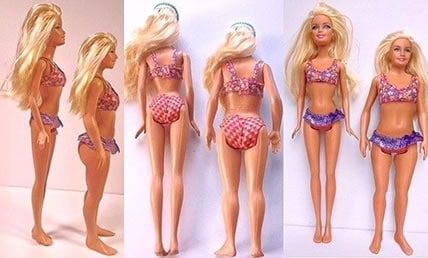By: April McCarthy,
Research has for years linked women’s exposure to barbie and photos of skinny supermodels with feelings of inadequacy about their own bodies.Very young girls as young as 4 years old are beginning to think of themselves as needing to be sexy, pretty, skinny and even as sex objects according to several studies of elementary school children.
This picture above is what Barbie would look like if she were based on the average 19-year-old woman. Artist Nickolay Lamm used 3D printing technology and information from the CDC to create a “normal” Barbie — and the comparison to the doll is truly startling. This comparison proves that the beauty ideals we’re exposed to at a very young age are, for the most part, completely unrealistic.

These days, it is not unusual for girls as young as age 4 to try to emulate the look of glamorous fashion models and wispy television stars–a trend that may be linked to eating disorders among young children.
But according to two studies in Pediatrics, the media is not the only influence on the eating habits of today’s youth. Parents may play a more significant role than both the media and peers in the way young children view themselves and their bodies, researchers report.
A study of more than 6,700 children and adolescents found that both boys and girls who said that their fathers were concerned with their weight were more than twice as likely to become constant dieters compared with their peers, one year later. Boys and girls who reported that their mother was constantly dieting were also more likely to become concerned with their own weight and diet frequently, the report indicates.
The weight-related issues of parents are transmitted to their children, therefore it is important that parents remind themselves that they serve as role models and therefore should attempt to adopt the diet and activity patterns they would like their children to emulate.
6-Years Olds And Younger
Nearly half of the 3- to 6-year-old girls in a previous study by University of Central Florida psychology professor Stacey Tantleff-Dunn and doctoral student Sharon Hayes said they worry about being fat. About one-third would change a physical attribute, such as their weight or hair color.
The number of girls worried about being fat at such a young age concerns Tantleff-Dunn because of the potential implications later in life. Studies have shown that young girls worried about their body image are more likely to suffer from eating disorders when they are older.
The media’s portrayal of beauty likely is one of the strongest influences on how they perceive their bodies because children spend so much time watching movies and television, Tantleff-Dunn said.
“The genetic and environmental origins of pregnancy-associated cancers are likely to pre-date the pregnancy but the hormones and growth factors necessary for a baby to develop may accelerate the growth of a tumour,” Roberts said.
Eating disorder experts say prepubescent girls are developing eating disorders as young as 5 and 6 years old. They may be getting their obsession from parents who are preoccupied with their own body images, and media images of skinny pop stars like Christina Aguilera and Britney Spears, the experts say.
Children learn (unhealthy) mainstream attitudes towards food and weight at a very young age. The number of children younger than 12 entering the hospital for eating disorders increased 119 percent between 1999 and 2006.
Researchers have shown in the past that women and teens think of themselves in sexually objectified terms, but a new study is the first to identify self-sexualization in young girls. The study, published online July 6 in the journal Sex Roles, also identified factors that protect girls from objectifying themselves.
An entire generation of young girls is being psychologically damaged by the onslaught of marketing tactics surrounding inappropriate “sexy” children’s fashions, toys, music, books and sexualized images in the media, and parents should be very concerned.
A controversial clothing company drew fire from parents after it began marketing padded bikini tops in its latest swimsuit line at abercrombie kids, the company’s shop for boys and girls.
The current generation of young girls and boys are being psychologically damaged by the onslaught of inappropriate “sexy” children’s fashions, toys, music, books and sexualized images in the media. It should be an issue of great concern for all parents.
Sexualizing children is not funny and it’s not a joke, and if parents don’t start paying attention to what the American Psychological Association(APA) report found to be the growing trend to sexualize young girls and boys through video games, television shows, movies, music videos, song lyrics, magazines, clothing styles and toys, you’ll find yourself scratching your head wondering what happened to your little prince or princess well before they reach the teen years.
DISTRUBING FACTS ON BODY IMAGE AND EATING DISORDERS
A study showed that women experience an average of 13 negative thoughts about their body each day, while 97% of women admit to having at least one “I hate my body” moment each day.
(Source: raderprograms.com)
Only 5% of women naturally have the body type advertisements portray as ideal. (Source: ndsu.edu)
Of 5th to 12th grade girls surveyed: 47% reported wanting to lose weight because of magazine pictures. 69% said that magazine pictures influenced their idea of what the “picture body” looks like. (Source:kidseatwell.org)
The dieting industry generates at least $55.4 billion in revenue every year. (Source: about-face.org)
In a survey of girls aged approximately 14-18: More than 59% of girls were trying to lose weight. In the last 30 days before the survey, over 18% of girls had starved themselves for a day or more to lose weight. 11.3% of girls surveyed had used diet pills and 8.4% had vomited or taken laxatives to lose weight (Source: casacolumbia.org)
One study found that elite athletes experienced much higher rates of eating disorders (20%) than did a female control group (9%). Female athletes in ‘aesthetic sports’ (i.e. gymnastics, ballet, figure skating) have the highest risk for developing eating disorders (Source: olympic.org)
41% of first to third-grade girls want to be thinner, while 81 percent of 10-year-olds are afraid of getting fat. 80% of 10-year-old American girls say they have been on a diet. The number one magic wish for young girls age 11-17 is to be thinner. (Source: missrepresentation.org)
As many as 24 million people suffer from an eating disorder — including anorexia, bulimia and binge eating disorder — in the U.S. alone. (Source:anad.org)
91% of undergraduate women surveyed admitted that they diet. 22% dieted “often” or “always”. (Source: scu.edu)
42% of 1st-3rd grade girls wish they were thinner. 81% of 10 year olds are afraid of being fat. (Source: raderprograms.com)
50% of commercials directed towards women mention physical attractiveness. The average adolescent views over 5,000 advertisements that mention attractiveness annually. (Source: raderprograms.com)
Credits:
This article first appeared on Prevent Disease.


